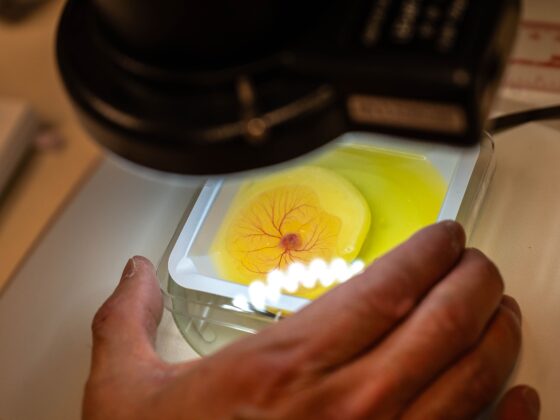Annual screening for ovarian cancer detects cancer earlier but does not save lives, concludes the largest ovarian cancer screening trial up to now. On the basis of the UK study, published in The Lancet (13th May 2021), general population screening for ovarian cancer cannot be recommended. The study, investigators say, highlights the importance of requiring evidence that any potential screening test for ovarian cancer actually reduces disease-specific mortality as well as detecting cancers earlier.
Ovarian cancer represents the most lethal gynaecological malignancy, in part because it presents with non-specific symptoms. Statistics show 58% of women are diagnosed at stage III or IV, with a five-year survival of 27% for stage III and 13% for stage IV, in comparison to 90% for those detected at stage I. The goal of screening is to save lives by identifying women with stage I disease that is highly treatable. The UK Collaborative Trial of Ovarian Cancer screening (UKCTOCS) study was designed to test the hypothesis that a reliable screening method that identifies ovarian cancer earlier, when treatments are more likely to be effective, could save lives.
For the study, between 2001 and 2005 investigators from University College London recruited 202,638 postmenopausal women, aged between 50 and 74 years, from the general population via 13 UK centres. Screening lasted until 2011, with the women randomly assigned in a 1:1:2 ratio to receive either annual multimodal screening (MMS, n=50,625), annual transvaginal ultrasound screening (n=50,623), or no screening (n=101,314). MMS involves a blood test that monitors changes in levels of the CA125 protein, which is found on the surface of ovarian cancer cells and some normal tissue, followed by a transvaginal ultrasound scan as a second test. To interpret longitudinal changes in CA125, the team used a risk of ovarian cancer algorithm comparing an individual women’s changes in CA125 levels over time with that of ovarian cancer cases and controls. “This approach gives a far more accurate idea of the woman’s personal risk of ovarian cancer, compared to the conventional screening method, which uses a fixed ‘cut-off’ point for CA125,” explains Usha Menon, the lead investigator of UKCTOCS. “The tell-tale sign of ovarian cancer is an ‘elbow’ shaped curve, where there is a sudden change point where CA125 levels suddenly take off.”
For the study, women were linked using their NHS (National Health Service) number to national cancer and death registration data, with the definitive diagnosis of ovarian cancer provided by histopathology following surgery or imaging guided biopsy. When the initial analysis of deaths occurred in 2015, there was not enough data to conclude whether or not screening reduced deaths, so the investigators therefore looked at five more years of follow up data.
On average, women in the screening groups underwent eight annual screens over the course of the study. Results at a median follow-up of 16.3 years found that, although the incidence of early-stage cancers was 39% higher in the MMS than in the no screening group, this did not translate to a reduction in deaths. There was no difference between the three groups in terms of the death rate from ovarian cancer – 296 (0.6%) of women in the MMS group died from the disease versus 291 (0.6%) in the ultrasound group versus 619 (0.6%) in the no screening group.
For the MMS group, there was a shift in disease stage at diagnosis, with women having a 24.5% lower incidence of stage IV ovarian cancers and a 47.2% higher incidence of stage I ovarian cancers than women randomly assigned to no screening, but this difference was accompanied by higher case fatality rates for stage I cancers (14.8% in the MMS group versus 9.4% in the no screening group). For women in the ultrasound group there was no difference in stage of disease detected in comparison to the no screening group.
“We are disappointed as this is not the outcome we and everyone involved in the trial had hoped and worked for over so many years. To save lives, we will require an even better screening test that detects ovarian cancer earlier and in more women than the MMS strategy we used,” says Menon.
One possible explanation for the results, she suggests, might be that CA125 differentially identifies aggressive ovarian cancers early, and that these cancers do not respond as well to treatment as usual stage I cancers. “We are now in the midst of more detailed analyses of the treatment women received to help us understand this better,” explains Menon.
The study, stresses Menon, does not write off ovarian cancer screening overall. “I hope that this is just a setback in the wider context of the early detection screening space for ovarian cancer. There was a number of novel biomarkers in development that can be used alongside CA125 to save lives.”
In an accompanying commentary, Lauren Hurwitz, Paul Pinsky and Britton Trabert, from the National Cancer Institute, Rockville, Maryland, write, “Does this study signal the end of general population ovarian screening with CA125 and USS? For CA125 and USS (annual trans vaginal ultrasound screening) alone or in combination, it is probable, given the scale and rigour of these trials and the consistent finding of no reduction in ovarian cancer mortality.” They add that there is potential for additional biomarkers, such as circulating tumour DNA, micro RNAS, and DNA methylation, to be used in combination with CA125. “But these markers as screening tools will need to be further developed, validated, and ultimately tested in randomised controlled trials.”
Menon agrees that there will be no fast answers. “Sadly, testing the new markers is likely to require significant time, so that in reality it might be over a decade before population screening programmes can be implemented,” she says. Even after a screening approach is found to save lives, she adds, there are other strategic issues that need to be determined, such as cost-effectiveness of the strategy.
The investigators stress that in ovarian cancer there are major differences between general asymptomatic population screening and testing for symptomatic women. “There have been significant improvements in the treatment of advanced disease in the last 10 years, since screening in our trial ended. In women who do have symptoms, earlier diagnosis, combined with this better treatment, can still make a difference to quality of life and, potentially, improve outcomes,” says Mahesh Parmar, Director of the MRC Clinical Trials Unit at UCL and a senior author on the paper.












